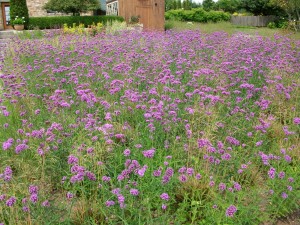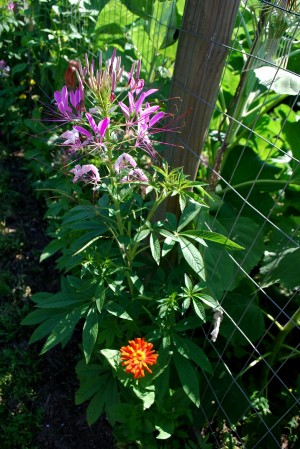By Michelle Sutton My friend Bill likes to say that, for both people and plants, “Volunteers are happiest.” Every year dozens of volunteer vegetable and flower seedlings emerge in my community garden plot, popping up conveniently in corners and inconveniently in the middle of paths. Either way, I’d always assumed that as volunteers likely reverting to characteristics of one parent over the other (“reverting to type”), their flavor or beauty would be inferior, and I’d rogue them out. But I’m rethinking that now. Last year, volunteer snapdragons were quite showy, and I had some very tasty butternut squash from a volunteer plant.

Queen Anne’s lace in the Coyne/DiNezza garden is embraced as one of the garden’s signatures. Photo by Craig Coyne
With regard to plants of all types, how do we decide the fate of our volunteers? I asked for observations from popular garden writer, consultant, and speaker Sally Jean Cunningham (www.sallycunningham.org); from the co-creator of a multi-acre plant-lover’s paradise in Scottsville, Jim Lesch; and from Rochester Civic Garden Center trustee and owner of Perennial Designs (garden design & consulting), Milli Piccione.
Sally Jean Cunningham: As I have matured as a gardener, I am sadder but wiser about volunteers. I do remember being the young vegetable gardener who cheerfully welcomed a bit of “free” mint (Mentha sp.), imagining mint juleps and believing I had room for a few plants. Truth is: there is no such thing as a little mint. That’s also true of most volunteer plants. The volunteer maple tree sapling is probably a Norway maple (Acer platanoides, an undesirable invasive plant) and not a coveted sugar maple. The yellow iris that appeared next to the pond is a thug called Iris pseudacorus. And I remember a near disaster when I was working around a free Angelica archangelica (I thought) and a gardening friend pulled me away—as if from an oncoming train—because it was a giant hogweed! So be careful—there is rarely a free, desirable plant. There are exceptions to my cautionary approach, however. In my companion-style vegetable garden, where flowers and herbs are mixed among the vegetables, I have always allowed several volunteers to remain. Asters (Aster spp.), milkweed (Asclepias spp.), Shasta daisies (Leucanthemum x superbum), and seedlings from last season’s cleome (Cleome spp.), dill (Anethum graveolens), or love-in-a-mist (Nigella damascena) are all great for pollinators or other beneficial insects. In the Coyne/DiNezza garden in Buffalo (a popular stop on the Snyder-CleveHill Garden View and AAA Motorcoach tours), the gardeners willingly permit Queen Anne’s lace (Daucus carota) to pop up intermittently, quite aware that removing them can be a chore. In this garden, their airy little heads, waving among traditional perennials, have become part of the Coyne/DiNezza garden’s signature.
Jim Lesch: Richard LeRoy and I converted several acres of former farmland in Scottsville to gardens. Behind our property there are still farm fields, hedgerows, and woods. From that reservoir, native plants come unbidden in their effort at succession back to forest. We find volunteer honeysuckle (Lonicera spp.) and dogwood (Cornus spp.) shrubs on a regular basis. We keep a handful of these at the edge of our property to blend visually with the hedgerows in the distance. In the last five years, junipers (Juniperus spp.) have also appeared; these could be either volunteers from native junipers or our own ornamentals reverting to a parent juniper species. We have relocated and kept most of these. They are a bit rangy, but they do have an interesting bluish cast and tight columnar shape. To us they seem more vigorous and likely to survive on our alkaline soil than the named ornamentals we have introduced. Besides the “volunteers” coming from the fields (and dandelions from our neighbors), some of our ornamentals also spawn volunteers. For instance, many of our maples have sown profusely. We removed a nearly mature Norway maple to end its invasive ways. A hedgerow of Amur maples (Acer ginnala) and a single paperbark maple (A. griseum) have reproduced widely and are thus weeds as far as we are concerned. On the other hand, we were delighted that one of our miniature Japanese maples (A. palmatum) seeded itself close by. We will dig and site it elsewhere or give it as a gift.

Tall verbena (Verbena bonariensis) can create a beautiful stand if allowed the space to reseed with abandon. Photo by Michelle Sutton
A few of our yews (Taxus spp.) seed themselves. We are often unsure whether the new plants are going to be spreading or upright yews, since we have both in our gardens. Pine (Pinus spp.) and spruce (Abies spp.) seeds also occasionally sprout. It is a joyous feeling to see Mother Nature doing so well on our reclaimed agricultural land, but often we cull these offspring to avoid ending up a forest rather than a garden. Among perennial flowers that spread, the winners in our garden are undoubtedly the violets (Viola spp.). We remove literally four to six wheelbarrow loads from our planting beds each year. If we did not do this, many other perennials could not survive due to unrelenting competition from the violets. The short woodland grasses and the Northern sea oats (Chasmanthium latifolium) we’ve planted have volunteered here and there and seem to cheerfully tolerate not just some shade, but dry clay. Last year we removed most of a stand of sea oats to make room for other plants, but we still have some to enjoy. We planted ajuga (Ajuga spp.) in partial shade. It kept sowing itself some feet away in the lawn. Over the years we have removed these volunteers several times to establish ajuga elsewhere.
Milli Piccione: I started gardening in earnest in my early 30s. My naive vision was that the gardens were going to be orderly, wellthought out, and totally under my control. After the first season of obsessed planting and weeding, I started to relax ‘just a bit’ and observe and appreciate the habits of my perennials and annuals. I also began to realize that Mother Nature’s volunteers could sometimes be my allies, not my enemies. The first volunteer of note in my small woodland area was a magnificent biennial—the 5-foot-tall velvety foliaged mullein (Verbascum spp.). I learned that it attracted seed-eating birds and became a believer the next day watching nuthatches zipping up and down the matured flower stalk feasting on the seeds. What a delight! As I became more experienced and more observant I left select volunteer perennials and annuals in place.In one little section of my rock garden I had planted the dwarf Solomon’s seal (Polygonatum humile) adjacent to a miniature narrow gold-leaved hosta (Hosta sp.). After two or three years, both started to travel and intertwine, forming an utterly charming combination. I’ve tried to recreate this effect in other gardens, the outcome never as successful as nature’s original. Self-seeded annuals and perennials can soften hardscaping as seeds, amazingly, germinate in the cracks and edges of walks and in dry-laid stone walls. The balance between a softening versus an unkempt look is in the vision of the gardener—your garden, your choice. Self-seeded perennials don’t usually get out-of-hand. Annuals, however, can take advantage of your generosity. My favorites are forget-me-nots (Myosotis spp.), tall verbena (Verbena bonariensis), and nicotiana (Nicotiana sylvestris). These can work if you’re willing to cull them when necessary, especially when the volunteers have to ‘play well with others’. Forget-me-nots are a favorite harbinger of spring—the diminutive flowers form an exquisite pale haze underneath spring bulbs. About three weeks after they have finished flowering, the fresh foliage turns dry and nasty looking. Rip out every plant once the seed has ripened; as you pull the plants you’re automatically broadcasting seed for the following year.

Nicotiana (Nicotiana sylvestris) is one of garden designer Milli Piccione’s most valued volunteer annuals. Photo by Milli Piccione
Tall verbena and nicotiana are 3 and 5 feet tall, respectively, and are both prolific self-seeders. Choosing which seedlings to keep depends on their neighbors and the final effect you want in your garden. The verbena is narrow with delicate purple flower heads that appear to float; it attracts monarch butterflies and other pollinators. Tall verbena is easy to tuck into existing beds, taking up little horizontal space. The opposite in its demands is the nicotiana—one plant can be 5 to 6 feet tall with 2-foot-long leaves and fragrant tubular white flowers. If you have the space they are magnificent as long as you are merciless when thinning, because they can easily shade out smaller plants.
Views: 2





